Spatial Usage Rate Model and Foot Vote Method for Thermal Comfort and Crowd Behaviour Analysis in Severe Cold Climate City Design
Abstract
1. Introduction
1.1. Literature Review
1.2. Objective and Motivation
- What are the distinctive patterns of crowd behavior (in terms of spatial distribution, attendance, duration of stay, and activity intensity) in China’s severe cold regions, and how are these patterns related to outdoor thermal comfort?
- Can objective observations of crowd behavior be applied to develop a reliable method for assessing subjective thermal comfort in severe cold climates?
- How do the findings on thermal comfort and crowd behavior in severe cold regions differ from those in other climatic zones, and what unique insights do these differences provide?
2. Methodology
2.1. Study Area
2.2. Experimental Process
2.2.1. Observation of Spatial Distribution (Experiment 1)
2.2.2. Attendance Statistics (Experiment 2)
2.2.3. Thermal Environment Measurement
2.3. Thermal Comfort Index
2.4. Multicollinearity Assessment
3. Results
3.1. Relationship Between Attendance and Thermal Comfort
3.1.1. Crowd Distribution in Sunlight and Shade
- (1)
- Sunlight exposure is insufficient—Certain locations in the area remain in shadow for most of the day. In the cold season, approximately 2/3 of the area experiences a shadow ratio of more than 80% for most of the day. In these areas, little seasonal difference is observed in Nsun/N.
- (2)
- Certain shaded areas are primarily provided by trees. In the areas where trees cast shadows, there are gaps in the shadows where sunlight shines through. As a result, the seasonal change in Nsun/N is less distinct. For example, in the N-S range, no significant difference is observed in Nsun/N amongst most grids across different seasons. In contrast, in the B-S range, which is shaded mainly by buildings the Nsun/N ratio of most areas gradually decreases from the cold season to the hot season because the N-S range mainly provides tree shade and the B-S range mainly provides architectural shadows.
- (3)
- The crowd is attracted by commercial activities. For example, some streets in certain directions or locations are almost always in the shade; however, due to the attraction of commercial activities, crowds will gather even in uncomfortable environments. In such cases, the influence of sunlight exposure on crowd distribution is overridden, making it difficult to establish a direct relationship.
3.1.2. Thermal Comfort and Attendance Patterns Across Seasons on Central Avenue
3.1.3. Stay Duration
3.2. Relationship Between Activity State and Thermal Comfort
3.2.1. Activity Intensity
3.2.2. Walking Speed
- (1)
- The time taken for a pedestrian to enter and exit the rectangular frame was recorded. Walking speed was then calculated by dividing the length of the rectangular frame by the recorded time.
- (2)
- The video was rewound to the moment the pedestrian was in the middle of the frame. The total number of people within the frame was counted and divided by the area to calculate pedestrian density.
- (3)
- Information such as the age and gender of the observed pedestrian was also recorded.
3.2.3. Seating Behaviour
4. Discussion
4.1. Crowd Behaviour Comparison with Other Regions
- (1)
- In hotter environments, both attendance and in Harbin are comparable to those in other regions with higher annual temperatures, particularly subtropical regions.
- (2)
- During winter, attendance and stay duration are significantly lower than in other regions; however, attendance can increase considerably due to the appeal of snow and ice landscapes, which attract both locals and tourists.
- (3)
- Walking speed in Harbin is lower than in other regions across all observed seasons. Based on the above analysis, this phenomenon may be attributed to the high metabolic rates of local residents, which are required to cope with extreme cold conditions.
4.2. Method of Measuring Thermal Comfort Using Crowd Behaviour
4.2.1. Usage Rate Model—Based on Attendance
4.2.2. Foot Vote—Based on Spatial Distribution
4.3. Guidance for Design and Research Limitations
5. Conclusions
Author Contributions
Funding
Data Availability Statement
Acknowledgments
Conflicts of Interest
References
- Thorsson, S.; Honjo, T.; Lindberg, F.; Eliasson, I.; Lim, E.-M. Thermal Comfort and Outdoor Activity in Japanese Urban Public Places. Environ. Behav. 2007, 39, 660–684. [Google Scholar] [CrossRef]
- Lin, T.-P.; Tsai, K.-T.; Liao, C.-C.; Huang, Y.-C. Effects of Thermal Comfort and Adaptation on Park Attendance Regarding Different Shading Levels and Activity Types. Build. Environ. 2013, 59, 599–611. [Google Scholar] [CrossRef]
- Li, K.; Zhang, Y.; Zhao, L. Outdoor Thermal Comfort and Activities in the Urban Residential Community in a Humid Subtropical Area of China. Energy Build. 2016, 133, 498–511. [Google Scholar] [CrossRef]
- Watanabe, S.; Ishii, J. Effect of Outdoor Thermal Environment on Pedestrians’ Behavior Selecting a Shaded Area in a Humid Subtropical Region. Build. Environ. 2016, 95, 32–41. [Google Scholar] [CrossRef]
- Krüger, E.L.; Piaskowy, N.A.; Moro, J.; Minella, F.O. Identifying Solar Access Effects on Visitors’ Behavior in Outdoor Resting Areas in a Subtropical Location: A Case Study in Japan Square in Curitiba, Brazil. Int. J. Biometeorol. 2019, 63, 301–313. [Google Scholar] [CrossRef]
- Cheung, P.K.; Jim, C.Y. Subjective Outdoor Thermal Comfort and Urban Green Space Usage in Humid-Subtropical Hong Kong. Energy Build. 2018, 173, 150–162. [Google Scholar] [CrossRef]
- Han, S.; Song, D.; Xu, L.; Ye, Y.; Yan, S.; Shi, F.; Zhang, Y.; Liu, X.; Du, H. Behaviour in Public Open Spaces: A Systematic Review of Studies with Quantitative Research Methods. Build. Environ. 2022, 223, 109444. [Google Scholar] [CrossRef]
- Chen, Y.C.; Hou, K.S.; Liao, Y.J.; Honjo, T.; Cheng, F.-Y.; Lin, T.-P. The Application of a High-Density Street-Level Air Temperature Observation Network (HiSAN): Spatial and Temporal Variations of Thermal and Wind Condition in Different Climatic Condition Types. Sustain. Cities Soc. 2024, 109, 105547. [Google Scholar] [CrossRef]
- Li, J.; Niu, J.; Mak, M.C.; Huang, T.; Xie, Y. Exploration of Applicability of UTCI and Thermally Comfortable Sun and Wind Conditions Outdoors in a Subtropical City of Hong Kong. Sustain. Cities Soc. 2020, 52, 101793. [Google Scholar] [CrossRef]
- Kim, M.; Lee, K.; Cho, G.H. Temporal and Spatial Variability of Urban Heat Island by Geographical Location: A Case Study of Ulsan, Korea. Build. Environ. 2017, 126, 471–482. [Google Scholar] [CrossRef]
- Yan, H.; Fan, S.; Guo, C.; Wu, F.; Zhang, N.; Dong, L. Assessing the Effects of Landscape Design Parameters on Intra-Urban Air Temperature Variability: The Case of Beijing, China. Build. Environ. 2014, 76, 44–53. [Google Scholar] [CrossRef]
- Kántor, N.; Unger, J. Benefits and Opportunities of Adopting GIS in Thermal Comfort Studies in Resting Places: An Urban Park as an Example. Landsc. Urban. Plan. 2010, 98, 36–46. [Google Scholar] [CrossRef]
- Nikolopoulou, M.; Lykoudis, S. Use of Outdoor Spaces and Microclimate in a Mediterranean Urban Area. Build. Environ. 2007, 42, 3691–3707. [Google Scholar] [CrossRef]
- Thorsson, S.; Lindqvist, M.; Lindqvist, S. Thermal Bioclimatic Conditions and Patterns of Behaviour in an Urban Park in Göteborg, Sweden. Int. J. Biometeorol. 2004, 48, 149–156. [Google Scholar] [CrossRef] [PubMed]
- Lopes, H.S.; Remoaldo, P.C.; Ribeiro, V.; Martín-Vide, J. Perceptions of Human Thermal Comfort in an Urban Tourism Destination—A Case Study of Porto (Portugal). Build. Environ. 2021, 205, 108246. [Google Scholar] [CrossRef]
- Fan, Q.; Li, X.; Li, H. Crowd Gathering and Thermal Comfort Research in Different Park Shading Spaces. Sustainability 2022, 14, 2687. [Google Scholar] [CrossRef]
- Laureti, F.; Martinelli, L.; Battisti, A. Assessment and Mitigation Strategies to Counteract Overheating in Urban Historical Areas in Rome. Climate 2018, 6, 18. [Google Scholar] [CrossRef]
- Guo, Z.; Watanabe, N.; Setoguch, T.; Huo, K. Urban Canyon Microclimate and Spatial Behavior in Extreme Climate Situations. Int. J. Archit. Urban Dev. 2019, 9, 22–34. [Google Scholar]
- Kim, S.W.; Brown, R.D. Pedestrians’ Behavior Based on Outdoor Thermal Comfort and Micro-Scale Thermal Environments, Austin, TX. Sci. Total Environ. 2022, 808, 152143. [Google Scholar] [CrossRef]
- Lin, T.-P. Thermal Perception, Adaptation and Attendance in a Public Square in Hot and Humid Regions. Build. Environ. 2009, 44, 2017–2026. [Google Scholar] [CrossRef]
- Huang, K.-T.; Lin, T.-P.; Lien, H.-C. Investigating Thermal Comfort and User Behaviors in Outdoor Spaces: A Seasonal and Spatial Perspective. Adv. Meteorol. 2015, 2015, 423508. [Google Scholar] [CrossRef]
- Lin, C.-H.; Lin, T.-P.; Hwang, R.-L. Thermal Comfort for Urban Parks in Subtropics: Understanding Visitor’s Perceptions, Behavior and Attendance. Adv. Meteorol. 2013, 2013, 640473. [Google Scholar] [CrossRef]
- Lin, T.-P.; Tsai, K.-T.; Hwang, R.-L.; Matzarakis, A. Quantification of the Effect of Thermal Indices and Sky View Factor on Park Attendance. Landsc. Urban. Plan. 2012, 107, 137–146. [Google Scholar] [CrossRef]
- Huang, J.; Zhou, C.; Zhuo, Y.; Xu, L.; Jiang, Y. Outdoor Thermal Environments and Activities in Open Space: An Experiment Study in Humid Subtropical Climates. Build. Environ. 2016, 103, 238–249. [Google Scholar] [CrossRef]
- Cheng, B.; Gou, Z.; Zhang, F.; Feng, Q.; Huang, Z. Thermal Comfort in Urban Mountain Parks in the Hot Summer and Cold Winter Climate. Sustain. Cities Soc. 2019, 51, 101756. [Google Scholar] [CrossRef]
- Guo, W.; Jiang, L.; Cheng, B.; Yao, Y.; Wang, C.; Kou, Y.; Xu, S.; Xian, D. A Study of Subtropical Park Thermal Comfort and Its Influential Factors during Summer. J. Therm. Biol. 2022, 109, 103304. [Google Scholar] [CrossRef] [PubMed]
- Deng, Y.; Gan, D.; Tang, N.; Cai, Z.; Li, X.; Chen, S.; Li, X. Research on Outdoor Thermal Comfort and Activities in Residential Areas in Subtropical China. Atmosphere 2022, 13, 1357. [Google Scholar] [CrossRef]
- Boumaraf, H.; Amireche, L. Thermal Comfort and Pedestrian Behaviors in Urban Public Spaces in Cities with Warm and Dry Climates. Open House Int. 2020, 46, 143–159. [Google Scholar] [CrossRef]
- Niu, J.; Xiong, J.; Qin, H.; Hu, J.; Deng, J.; Han, G.; Yan, J. Influence of Thermal Comfort of Green Spaces on Physical Activity: Empirical Study in an Urban Park in Chongqing, China. Build. Environ. 2022, 219, 109168. [Google Scholar] [CrossRef]
- Faustini, F.B.; de Faria, J.R.G.; Fontes, M.S.G.d.C. The Influence of Thermal Comfort Conditions on User’s Exposure Time in Open Spaces. Int. J. Biometeorol. 2020, 64, 243–252. [Google Scholar] [CrossRef]
- Xue, J.; Liu, W.; Liu, K. Influence of Thermal Environment on Attendance and Adaptive Behaviors in Outdoor Spaces: A Study in a Cold-Climate University Campus. Int. J. Environ. Res. Public Health 2021, 18, 6139. [Google Scholar] [CrossRef] [PubMed]
- Zacharias, J.; Stathopoulos, T.; Wu, H. Spatial Behavior in San Francisco’s Plazas: The Effects of Microclimate, Other People, and Environmental Design. Environ. Behav. 2004, 36, 638–658. [Google Scholar] [CrossRef]
- Kim, Y.; Brown, R. Effect of Meteorological Conditions on Leisure Walking: A Time Series Analysis and the Application of Outdoor Thermal Comfort Indexes. Int. J. Biometeorol. 2022, 66, 1109–1123. [Google Scholar] [CrossRef]
- Tsai, K.-T.; Lin, Y.-H. Identification of Urban Park Activity Intensity at Different Thermal Environments and Visible Sky by Using Sound Levels. Int. J. Biometeorol. 2018, 62, 1987–1994. [Google Scholar] [CrossRef]
- Handoyo, A.D.; Wulandari, R.; Tiara, A.F. The Importance and Impact of User Behavior on Thematic Park; Atlantis Press: Dordrecht, The Netherlands, 2020; pp. 221–228. [Google Scholar]
- Wei, R.; Yan, J.; Cui, Y.; Song, D.; Yin, X.; Sun, N. Studies on the Specificity of Outdoor Thermal Comfort during the Warm Season in High-Density Urban Areas. Buildings 2023, 13, 2473. [Google Scholar] [CrossRef]
- Subedi, R.; Rijal, H.B.; Khadka, S.; Aqilah, N.; Lamsal, P. Development of Adaptive Thermal Comfort Model for Urban Park Based on Field Survey and Literature Review. Front. Built Environ. 2025, 10, 1526919. [Google Scholar] [CrossRef]
- Norouzi, M.; Chau, H.-W.; Jamei, E. Design and Site-Related Factors Impacting the Cooling Performance of Urban Parks in Different Climate Zones: A Systematic Review. Land. 2024, 13, 2175. [Google Scholar] [CrossRef]
- Alinasab, N.; Mohammadzadeh, N.; Karimi, A.; Mohammadzadeh, R.; Gál, T. A Measurement-Based Framework Integrating Machine Learning and Morphological Dynamics for Outdoor Thermal Regulation. Int. J. Biometeorol. 2025, 69, 1645–1662. [Google Scholar] [CrossRef]
- Sauquet, H.; Weston, P.H.; Anderson, C.L.; Barker, N.P.; Cantrill, D.J.; Mast, A.R.; Savolainen, V. Contrasted Patterns of Hyperdiversification in Mediterranean Hotspots. Proc. Natl. Acad. Sci. USA 2009, 106, 221–225. [Google Scholar] [CrossRef]
- Tousi, E.; Tseliou, A.; Mela, A.; Sinou, M.; Kanetaki, Z.; Jacques, S. Exploring Thermal Discomfort during Mediterranean Heatwaves through Softscape and Hardscape ENVI-Met Simulation Scenarios. Sustainability 2024, 16, 6240. [Google Scholar] [CrossRef]
- Romero, P.; Miranda, M.T.; Isidoro, R.; Arranz, J.I.; Valero-Amaro, V. Thermal Comfort and Sustainability in University Classrooms: A Study in Mediterranean Climate Zones. Appl. Sci. 2025, 15, 694. [Google Scholar] [CrossRef]
- Diz-Mellado, E.; López-Cabeza, V.P.; Roa-Fernández, J.; Rivera-Gómez, C.; Galán-Marín, C. Energy-Saving and Thermal Comfort Potential of Vernacular Urban Block Porosity Shading. Sustain. Cities Soc. 2023, 89, 104325. [Google Scholar] [CrossRef]
- Nastos, P.; Saaroni, H. Living in Mediterranean Cities in the Context of Climate Change: A Review. Int. J. Climatol. 2024, 44, 3169–3190. [Google Scholar] [CrossRef]
- Kántor, N. Differences between the Evaluation of Thermal Environment in Shaded and Sunny Position. Hung. Geogr. Bull. 2016, 65, 139–153. [Google Scholar] [CrossRef]
- Founda, D.; Katavoutas, G.; Pierros, F.; Mihalopoulos, N. The Extreme Heat Wave of Summer 2021 in Athens (Greece): Cumulative Heat and Exposure to Heat Stress. Sustainability 2022, 14, 7766. [Google Scholar] [CrossRef]
- Havenith, G.; Fiala, D. Thermal Indices and Thermophysiological Modeling for Heat Stress. Compr. Physiol. 2016, 6, 255–302. [Google Scholar] [CrossRef]
- Laouadi, A. Physiological Indicators of Thermal Comfort: A Comprehensive Approach Using the Metabolic-Based Predicted Mean Vote Index. Buildings 2024, 14, 3861. [Google Scholar] [CrossRef]
- Li, K.; Liu, X.; Bao, Y. Evaluating the Performance of Different Thermal Indices on Quantifying Outdoor Thermal Sensation in Humid Subtropical Residential Areas of China. Front. Environ. Sci. 2022, 10, 1071668. [Google Scholar] [CrossRef]
- Krüger, E.L.; Minella, F.O.; Matzarakis, A. Comparison of Different Methods of Estimating the Mean Radiant Temperature in Outdoor Thermal Comfort Studies. Int. J. Biometeorol. 2014, 58, 1727–1737. [Google Scholar] [CrossRef]
- Qin, J.; Tian, M.; Xu, X.; Yuan, L. Mapping High-Resolution Spatio-Temporal Patterns of Pedestrian Thermal Comfort at Different Scales Using Street View Imagery and Deep Learning. Sustain. Cities Soc. 2025, 121, 106209. [Google Scholar] [CrossRef]
- Shooshtarian, S.; Rajagopalan, P.; Wakefield, R. Effect of Seasonal Changes on Usage Patterns and Behaviours in Educational Precinct in Melbourne. Urban. Clim. 2018, 26, 133–148. [Google Scholar] [CrossRef]
- Blondin, D.P.; Haman, F. Shivering and Nonshivering Thermogenesis in Skeletal Muscles. Handb. Clin. Neurol. 2018, 156, 153–173. [Google Scholar] [CrossRef]
- Yuan, T.; Hong, B.; Qu, H.; Liu, A.; Zheng, Y. Outdoor Thermal Comfort in Urban and Rural Open Spaces: A Comparative Study in China’s Cold Region. Urban. Clim. 2023, 49, 101501. [Google Scholar] [CrossRef]
- GB 50352-2019; Unified Design Standard for Civil Buildings. Architecture & Building Press: Beijing, China, 2019.
- Peng, Z.; Wang, Y.; Li, L. Correlational Study on Thermal Comfort and Outdoor Activities. J. Phys. Conf. Ser. 2019, 1343, 012025. [Google Scholar] [CrossRef]
- Jin, H.; Liu, S.; Kang, J. Thermal Comfort Range and Influence Factor of Urban Pedestrian Streets in Severe Cold Regions. Energy Build. 2019, 198, 197–206. [Google Scholar] [CrossRef]
- Yang, Y.; Lyu, J.; Lian, Z.; Xie, Y.; Jiang, Y.; Lin, J.; Niu, J. Subjective Information in Thermal Comfort Evaluation Methods: A Critical Review. Energy Build. 2024, 325, 115019. [Google Scholar] [CrossRef]
- Fiala, D.; Lomas, K.J.; Stohrer, M. Computer Prediction of Human Thermoregulatory and Temperature Responses to a Wide Range of Environmental Conditions. Int. J. Biometeorol. 2001, 45, 143–159. [Google Scholar] [CrossRef]
- Weihs, P.; Staiger, H.; Tinz, B.; Batchvarova, E.; Rieder, H.; Vuilleumier, L.; Maturilli, M.; Jendritzky, G. The Uncertainty of UTCI Due to Uncertainties in the Determination of Radiation Fluxes Derived from Measured and Observed Meteorological Data. Int. J. Biometeorol. 2012, 56, 537–555. [Google Scholar] [CrossRef]
- Ainsworth, B.E.; Haskell, W.L.; Herrmann, S.D.; Meckes, N.; Bassett, D.R.; Tudor-Locke, C.; Greer, J.L.; Vezina, J.; Whitt-Glover, M.C.; Leon, A.S. 2011 Compendium of Physical Activities: A Second Update of Codes and MET Values. Med. Sci. Sport. Exerc. 2011, 43, 1575–1581. [Google Scholar] [CrossRef] [PubMed]
- Al-Azzawi, M.; Raeside, R. Modeling Pedestrian Walking Speeds on Sidewalks. J. Urban. Plan. Dev. 2007, 133, 211–219. [Google Scholar] [CrossRef]
- Lai, D.; Chen, B.; Liu, K. Quantification of the Influence of Thermal Comfort and Life Patterns on Outdoor Space Activities. Build. Simul. 2020, 13, 113–125. [Google Scholar] [CrossRef]

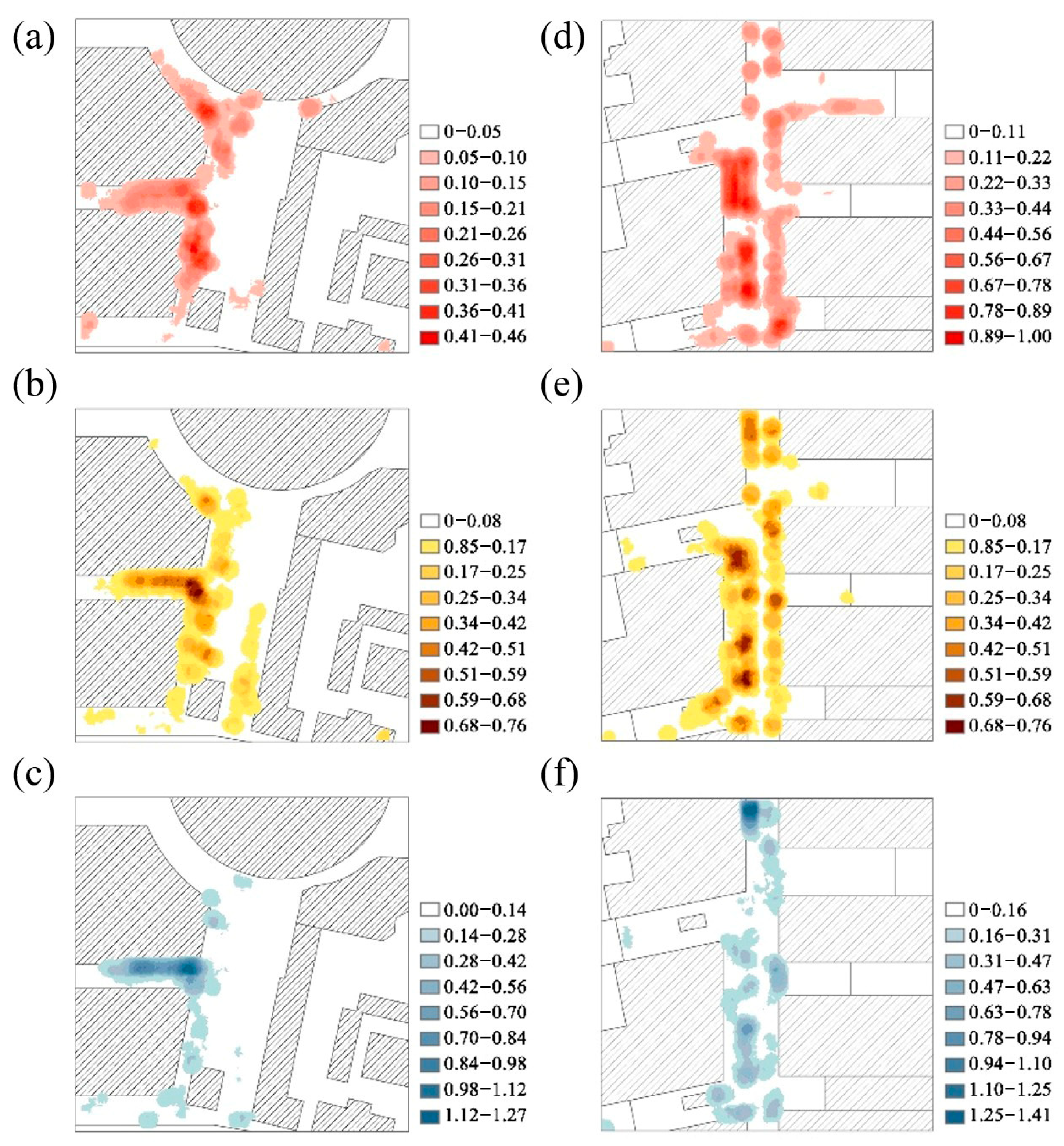
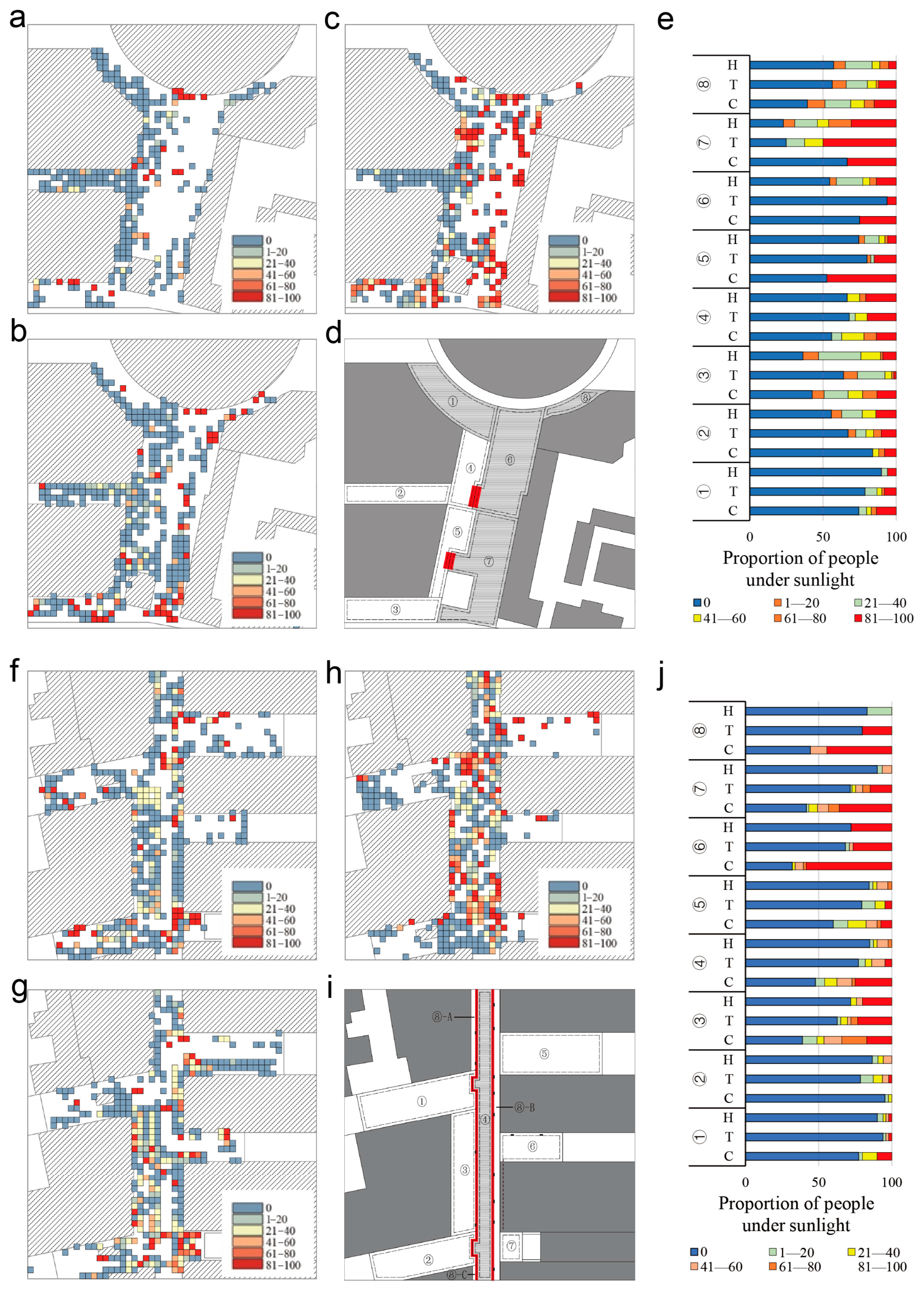

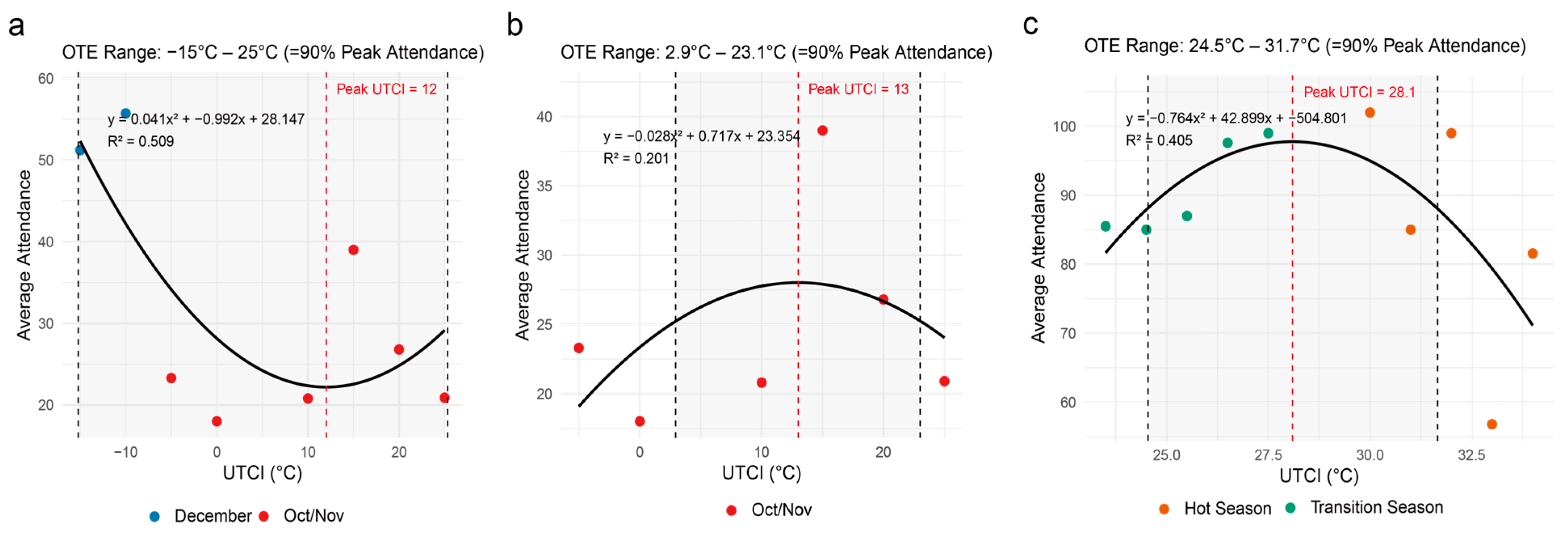

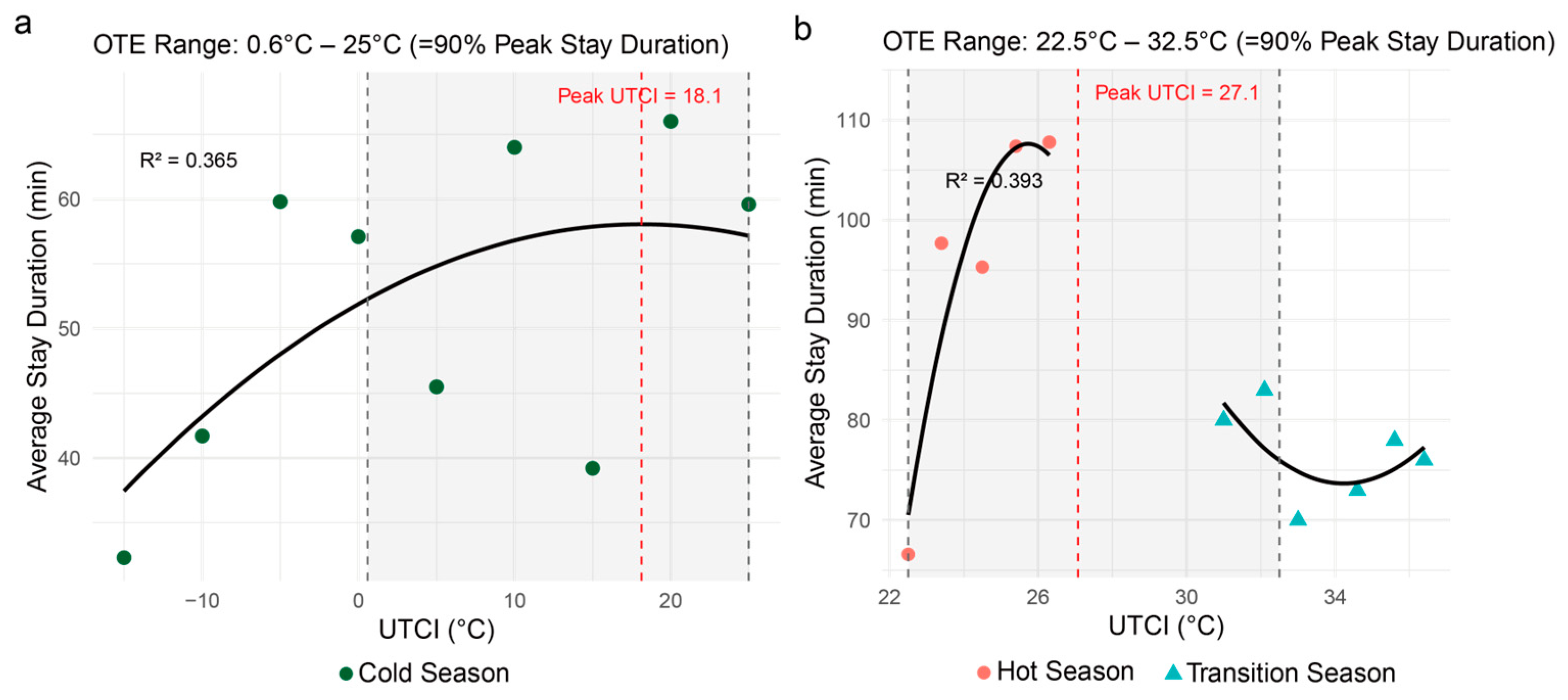

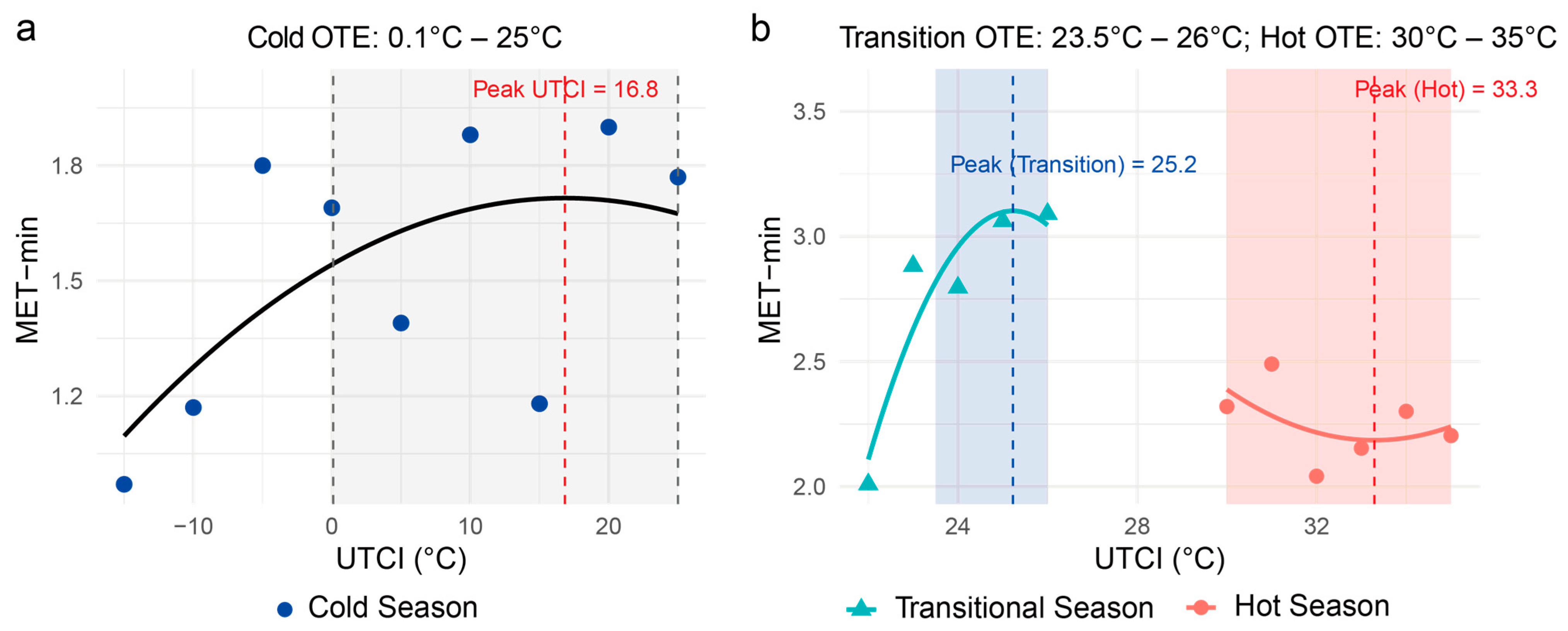
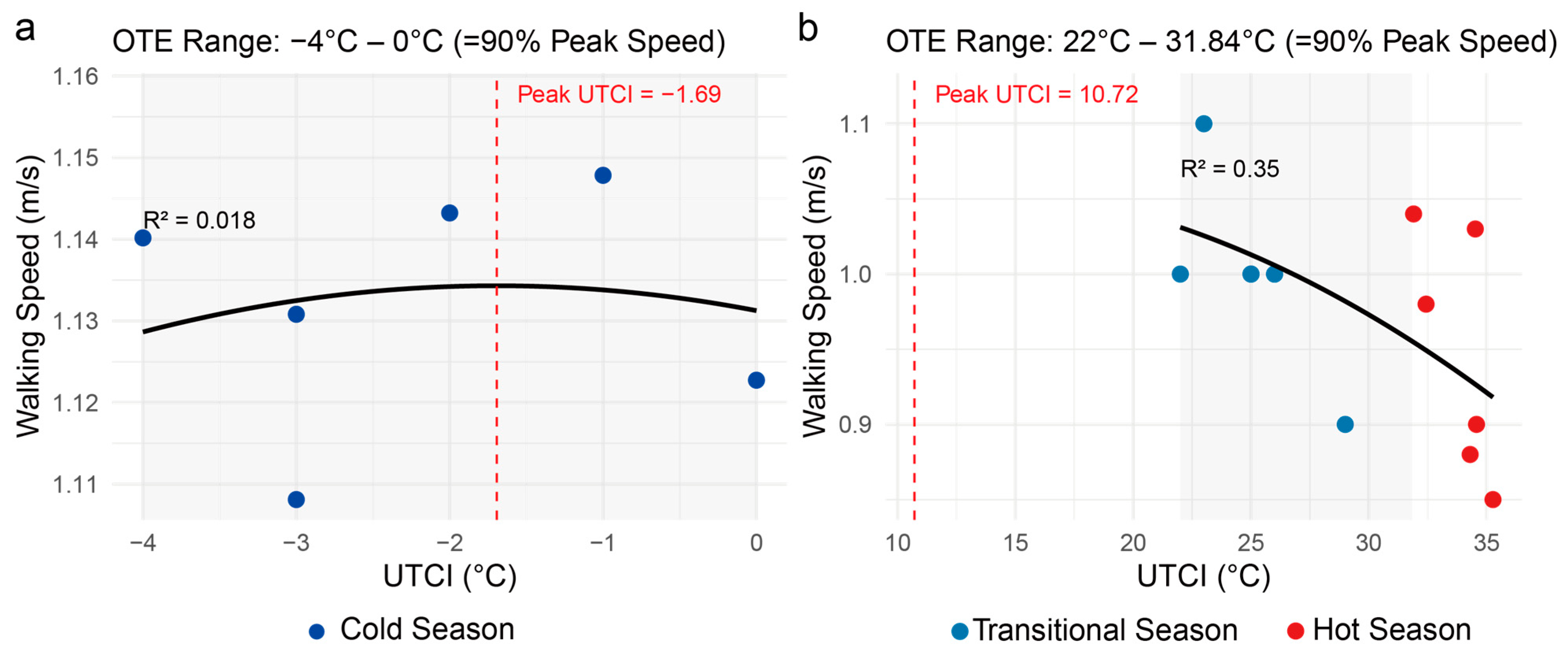
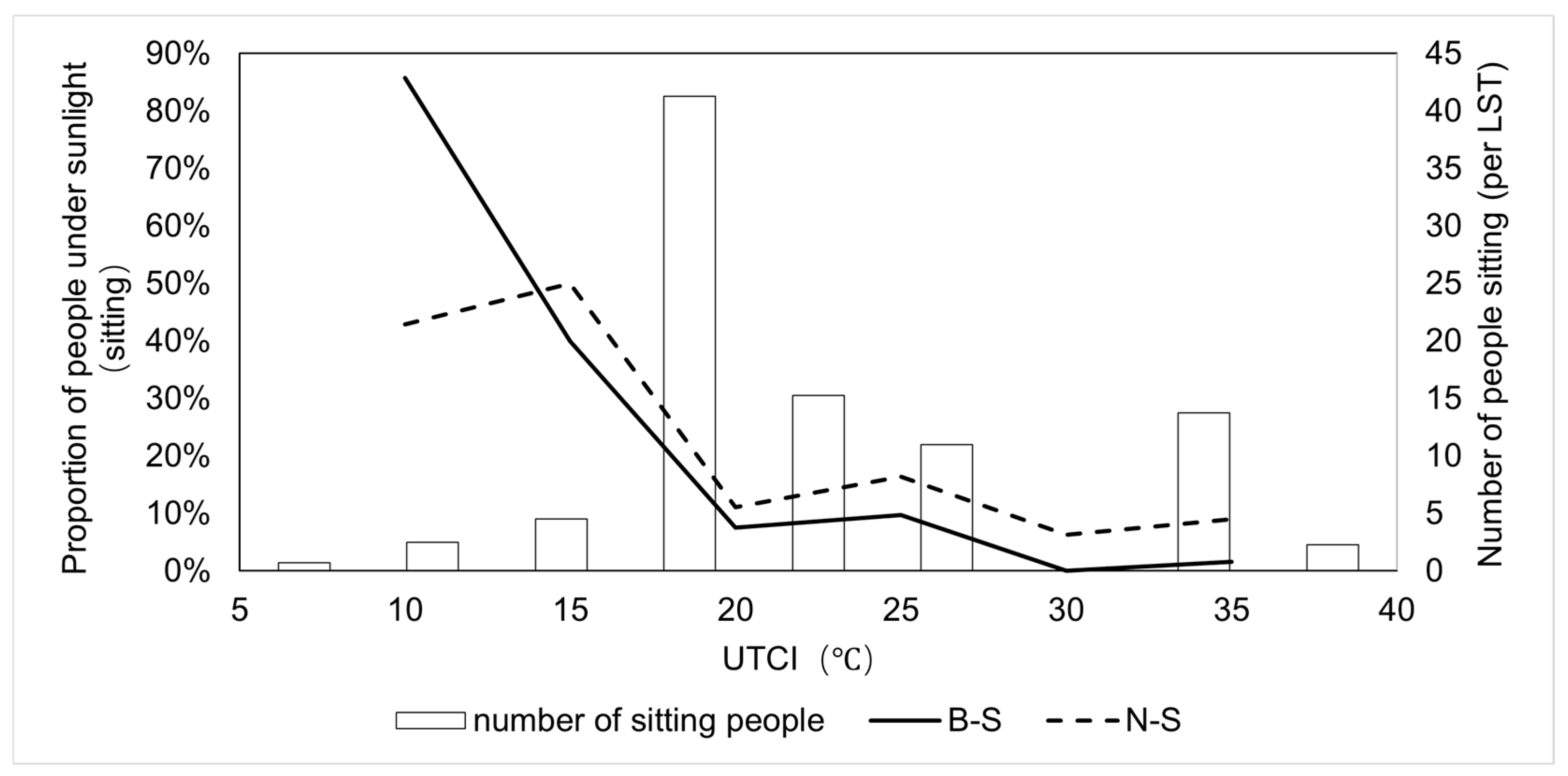

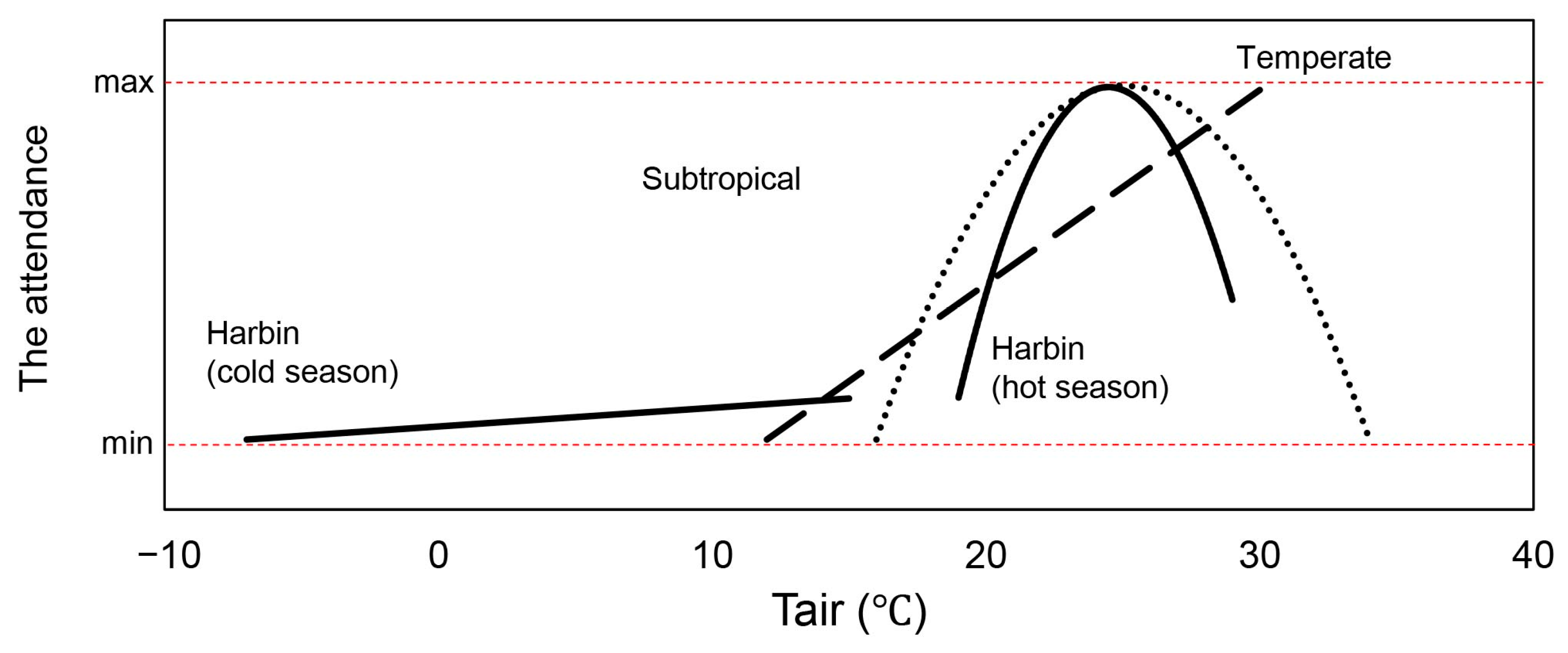


| Street Orientation | Area Division | Maximum Crowd Point Density | Partition | |||
|---|---|---|---|---|---|---|
| Cold | Transitional | Hot | ||||
| B-S | 45° north by west | Under the steps | 0.31 | 0.51 | 0.89 | ① |
| East west direction | Above the steps | 1.41 | 0.76 | 0.89 | ② | |
| 0.47 | 0.17 | 0.33 | ③ | |||
| 15° south by west | Above the steps | 0.47 | 0.42 | 0.56 | ④ | |
| 0.94 | 0.51 | 0.89 | ⑤ | |||
| Under the steps | 0.16 | 0.15 | 0.11 | ⑥ | ||
| 0.47 | 0.34 | 0.22 | ⑦ | |||
| 65° north by east | Under the steps | 0.16 | 0.15 | 0.33 | ⑧ | |
| N-S | 75° south by west | Outside the curbstone | 0.31 | 0.59 | 0.56 | ① |
| 0.63 | 0.59 | 0.56 | ② | |||
| East west direction | Outside the curbstone | 0.78 | 0.76 | 1.00 | ⑤ | |
| 0.31 | 0.43 | 0.44 | ⑥ | |||
| 0.31 | 0.25 | 0.33 | ⑦ | |||
| South north direction | Outside the curbstone | 0.63 | 0.17 | 0.33 | ③ | |
| 0.31 | 0.25 | 0.89 | ④ | |||
| Inside the curbstone | 1.41 | 0.59 | 0.89 | ⑧ | ||
| Non-Standardised Coefficient | Standardisation Coefficient | Significance | VIF | |||
|---|---|---|---|---|---|---|
| B | Standard Error | |||||
| Hot season | Tair | −21.10 | 5.54 | −0.89 | 0.00 | 1.01 |
| WS | 7.59 | 5.20 | 0.03 | 0.15 | 1.04 | |
| SR | 0.00 | 0.01 | 0.00 | 0.99 | 1.03 | |
| Transitional season | Tair | 7.153 | 11.57 | 0.01 | 0.54 | 1.10 |
| WS | −3.19 | 10.11 | −0.01 | 0.75 | 1.22 | |
| SR | −0.14 | 0.04 | −0.07 | 0.00 | 1.17 | |
| Cold season | Tair | 0.65 | 0.64 | 0.05 | 0.32 | 2.35 |
| WS | −2.90 | 10.20 | −0.01 | 0.78 | 1.05 | |
| SR | −0.01 | 0.02 | −0.02 | 0.67 | 2.36 | |
| Non-Standardised Coefficient | Standardisation Coefficient | Significance | VIF | |||
|---|---|---|---|---|---|---|
| B | Standard Error | |||||
| Hot season | Tair | −21.99 | 5.50 | −4.00 | 0.00 | 1.00 |
| SR | −0.00 | 0.01 | −0.01 | 0.82 | 1.00 | |
| Tair*SR | 0.07 | 0.02 | 0.07 | 0.00 | 1.00 | |
| Cold season | Tair | 0.44 | 0.42 | 0.03 | 0.30 | 1.01 |
| WS | −1.97 | 9.94 | −0.01 | 0.84 | 1.01 | |
| Tair*WS | −4.01 | 1.59 | −0.08 | 0.01 | 1.00 | |
| Cold season | WS | −0.81 | 9.97 | −0.00 | 0.94 | 1.01 |
| SR | 0.01 | 0.02 | 0.02 | 0.61 | 1.01 | |
| WS*SR | −0.11 | 0.05 | −0.06 | 0.05 | 1.00 | |
| Number | Activity | METs | Season | ||
|---|---|---|---|---|---|
| Cold | Transitional | Hot | |||
| 07040 | Standing/quietly | 1.3 | 11.4% | 17.1% | 15.6% |
| 09050 | Standing/talking, making phone calls or sending text messages | 1.8 | 84.8% | 79.3% | 79.3% |
| 13035 | Standing/Eating and talking | 2.0 | 2.7% | 1.6% | 2.7% |
| 09101 | Family reunion activities involving playing with children | 3.0 | 0.0% | 0.0% | 0.2% |
| 11870 | Work in a store, be an actor, be a staff member | 3.0 | 1.2% | 0.5% | 1.0% |
| 02045 | Regulatory exercise, fitness training | 3.5 | 0.0% | 1.4% | 1.1% |
| Country | Pedestrian Streets (m/s) | All Roads (m/s) | Climate Zone | Literature |
|---|---|---|---|---|
| France | - | 1.50 | temperate, Mediterranean, continental | [54] |
| New Zealand | - | 1.47 | Subtropical, temperate, Mediterranean | [57] |
| India | 1.19 | 1.20 | Tropical monsoon | [54] |
| Bangladesh | 1.15 | - | Subtropical monsoon | [56] |
| Saudi Arabia | - | 1.08 | Tropical Desert | [54] |
Disclaimer/Publisher’s Note: The statements, opinions and data contained in all publications are solely those of the individual author(s) and contributor(s) and not of MDPI and/or the editor(s). MDPI and/or the editor(s) disclaim responsibility for any injury to people or property resulting from any ideas, methods, instructions or products referred to in the content. |
© 2025 by the authors. Licensee MDPI, Basel, Switzerland. This article is an open access article distributed under the terms and conditions of the Creative Commons Attribution (CC BY) license (https://creativecommons.org/licenses/by/4.0/).
Share and Cite
Liu, S.; Jin, H. Spatial Usage Rate Model and Foot Vote Method for Thermal Comfort and Crowd Behaviour Analysis in Severe Cold Climate City Design. Buildings 2025, 15, 3812. https://doi.org/10.3390/buildings15213812
Liu S, Jin H. Spatial Usage Rate Model and Foot Vote Method for Thermal Comfort and Crowd Behaviour Analysis in Severe Cold Climate City Design. Buildings. 2025; 15(21):3812. https://doi.org/10.3390/buildings15213812
Chicago/Turabian StyleLiu, Siqi, and Hong Jin. 2025. "Spatial Usage Rate Model and Foot Vote Method for Thermal Comfort and Crowd Behaviour Analysis in Severe Cold Climate City Design" Buildings 15, no. 21: 3812. https://doi.org/10.3390/buildings15213812
APA StyleLiu, S., & Jin, H. (2025). Spatial Usage Rate Model and Foot Vote Method for Thermal Comfort and Crowd Behaviour Analysis in Severe Cold Climate City Design. Buildings, 15(21), 3812. https://doi.org/10.3390/buildings15213812





